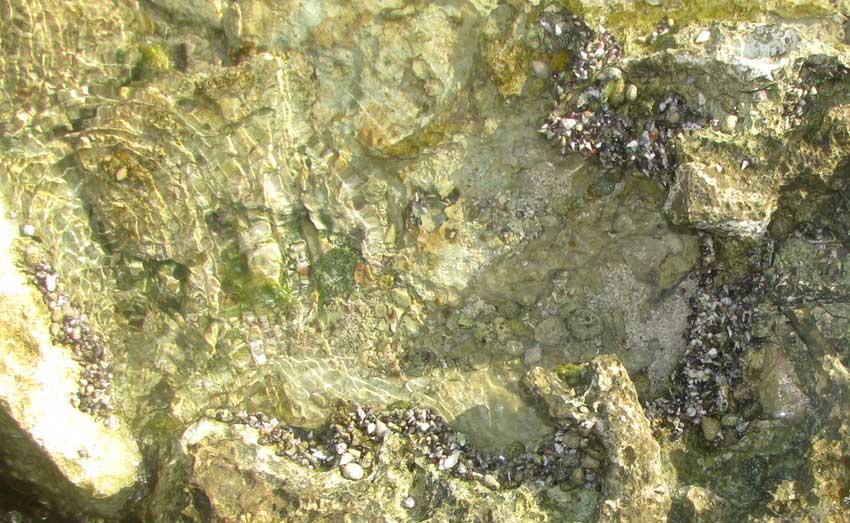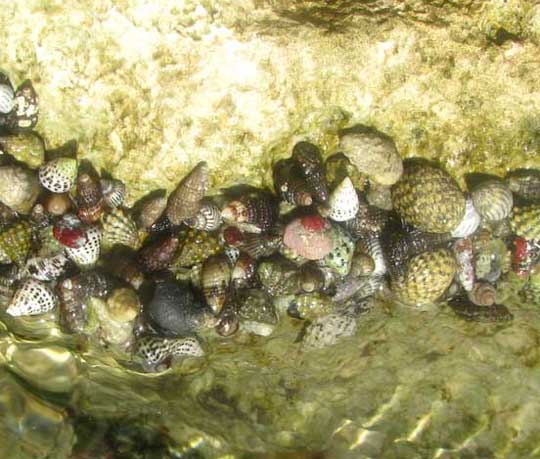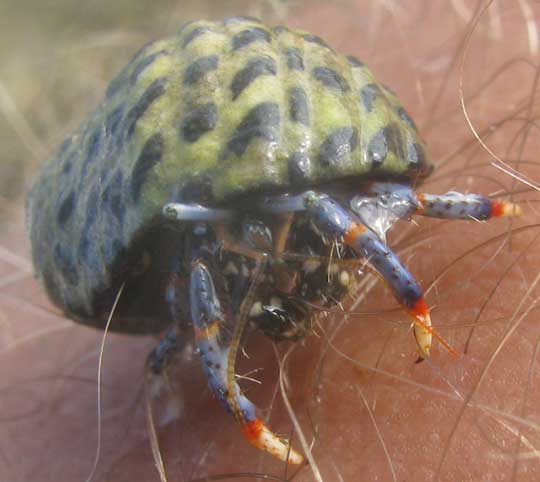Excerpts from Jim Conrad's
Naturalist Newsletter

from the August 28, 2011 Newsletter issued from Mayan Beach Garden Inn 20 kms north of Mahahual; Caribbean coastal beach and mangroves, ~N18.89°, ~W87.64°, Quintana Roo state, MÉXICO
MEXICAN BLUE LEGGED HERMIT CRAB
When the tide goes out, tide pools form at the rocky points. Sometimes interesting organisms show up in the pools, so I like to visit them, often just sitting for long periods gazing into the waters.
During one low-water visit when I stepped across a bathtub-size pool I noticed what seemed to be a granular crust formed at the pool's edges. My first impression was that tar from oil pollution had gathered at the pool's edges and now small seashells were sticking to the tar. You can see what I saw at the top of this page.
Up close I saw that they were indeed shells, mostly nerites -- which are marine snails -- of many sizes, colors and shapes, but there was no tar. The shells appeared to be self-gathered, as shown below:

Many of the shells were moving, but not with smooth, flowing motions typical of snails. They moved jerkily, as if on wobbly legs. I picked up one shell, put it on my hairy knee, and the source of this mystery shown below:

No snail this, but a hermit crab, a different species from the big ones so commonly seen crossing roads and sandy backyards here. Volunteer identifier Bea in Ontario pegs it as the Mexican Blue Legged Hermit Crab, CLIBANARIUS TRICOLOR. It's distributed from Florida and the Bahamas throughout the Caribbean, and as such goes by other English names as well, including Tricolor Hermit Crab, Equal Handed Hermit Crab, Blueleg Hermit Crab, and Dwarf Blue Leg Hermit Crab. The word "dwarf" in the last name reflects that this is a small crab, reaching only about 4/5 of an inch (2cm) in size.
Mexican Blue Legged Hermit Crabs are "detritivores," which means that they eat dead plants and animals, or detritus. It also sifts through the sand, "cleaning" it, as it feeds on algae, cyanobacteria and seaweed.
But all this doesn't explain why those thousands of crabs carrying all their varied borrowed shells formed such a crust at the edge of that particular pool. I could find no similar gatherings at other pools.
On the Internet I find a research paper reporting "clustering behavior" among Mexican Blue Legged Hermit Crabs in The Bahamas. Those researchers found that individual crabs in a cluster don't always stay in the same cluster, but might move around. However, explanation is given for why the crabs cluster to begin with.
Once again I'll just park this information and the pictures on the Internet, and hope they'll be useful to future students and naturalists.